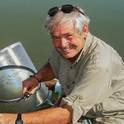
Article
Temperature and nutrient supply interact to control nitrogen fixation in oligotrophic streams: An experimental examination
Limnology and Oceanography
(2006)
Abstract
We performed two experiments to examine how temperature and nutrients interact to control dinitrogen (N2) fixation, chlorophyll a (Chl a) biomass, and community composition of periphyton in subalpine oligotrophic streams in the Sawtooth Mountains of Idaho. We grew periphyton on nutrient‐diffusing substrata (NDS) in a cold lake inlet (7°C) and a warm lake outlet (18°C). We then switched substrata between the two stream sites to test the effect of incubation temperature on N2‐fixation rates. Periphyton on substrata grown at both sites exhibited greater N2‐fixation rates when incubated in the warm outlet, which indicates physiologic temperature control. Periphyton on P‐enriched NDS grown in the warm outlet had the greatest N2‐fixation rates, largest Chl a biomass, and largest percentage of N2‐fixing taxa of any treatment, which indicates that temperature and P interact to influence the community. In the second experiment, colonized rocks and uncolonized NDS were placed in cold (13°C) and warm (18°C) mesocosms. Within 2 days, warm temperature stimulated N2 fixation by the rock periphyton community two times above cold temperatures, which indicates physiologic temperature control. After 45 days, warm temperatures and P enrichment led to Anabaena sp. in the periphyton community and the greatest rates of N2 fixation observed in the experiment, which also indicates temperature and nutrient control at the community level.
Disciplines
Publication Date
2006
DOI
https://doi.org/10.4319/lo.2006.51.5.2278
Citation Information
Wayne A. Wurtsbaugh. "Temperature and nutrient supply interact to control nitrogen fixation in oligotrophic streams: An experimental examination" Limnology and Oceanography Vol. 51 Iss. 5 (2006) p. 2278 - 2289 Available at: http://works.bepress.com/wayne_wurtsbaugh/226/
